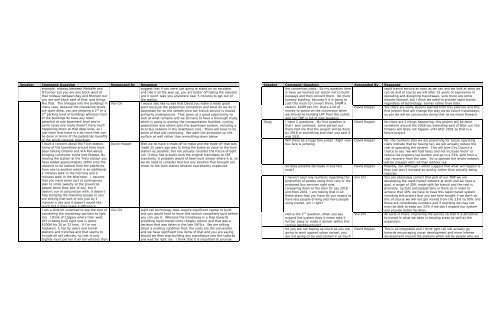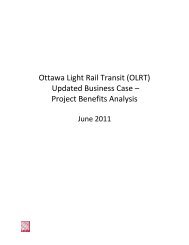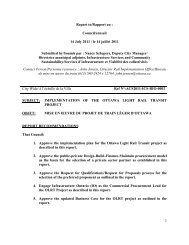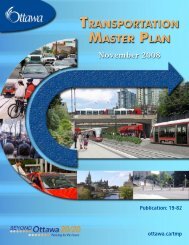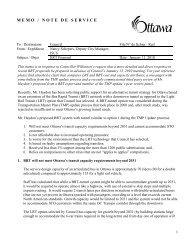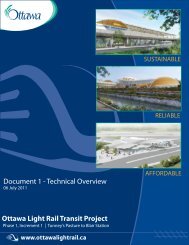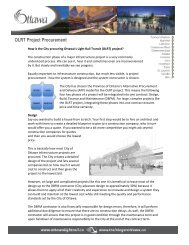Appendix A_Pages266to338_9MB.pdf - Ottawa Confederation Line
Appendix A_Pages266to338_9MB.pdf - Ottawa Confederation Line
Appendix A_Pages266to338_9MB.pdf - Ottawa Confederation Line
You also want an ePaper? Increase the reach of your titles
YUMPU automatically turns print PDFs into web optimized ePapers that Google loves.
Speaker Comment/Question Responded By Response<br />
example, midway between Metcalfe and<br />
O’Connor but you are one block west of<br />
that midway between Bay and Bronson but<br />
you are one block east of that, and things<br />
like that. The linkages into the buildings in<br />
many case, because the mezzanine levels<br />
are quite deep, you are showing a 2 nd or a<br />
3 rd parking level of buildings whereas most<br />
of the buildings do have any retail<br />
potential at sub-basement level and in<br />
some cases one really doesn’t have much<br />
happening down at that deep level, so I<br />
just think that there is a lot more that can<br />
be done in terms of the pedestrian benefits<br />
of the whole network downtown.<br />
Vivi Chi<br />
the station.<br />
I have a concern about the Train station.<br />
Some of the townships around here have<br />
been talking Ontario and VIA Rail about<br />
bringing commuter trains into <strong>Ottawa</strong>. By<br />
moving the station at the Train station you<br />
have added approximately 100m onto the<br />
distance to be walked from the platforms<br />
from one to another which is an additional<br />
2 minutes walk in the morning and 2<br />
minutes walk in the afternoon. I assume<br />
that you have some sort of contingency<br />
plan to smile sweetly at the provincial<br />
people when they sort of say, but it<br />
doesn’t run in conjunction with, it doesn’t<br />
help bringing the township people in you<br />
are sinking that sort of one just by 2<br />
minutes a day and it doesn’t sound like<br />
much but it does make a difference.<br />
I am a little bit surprised to see the cost of<br />
converting the transitway portions to light<br />
rail. I think of Calgary where their west<br />
LRT is being built right now is about<br />
$700M for 10 or 12 kms. If I’m not<br />
mistaken, it has fly overs and tunnel<br />
stations and trenches and that seems to<br />
include all rail vehicles, so that is only<br />
slightly more per km if all rail vehicles than<br />
David Hopper<br />
Vivi Chi<br />
suggest that if you were just going to stand on an escalator<br />
and ride it all the way up, you are better off taking the elevator<br />
and it won’t take you anywhere near 5 minutes to get out of<br />
I would also like to add that David you make a really good<br />
point because the pedestrian connection and what do we do in<br />
downtown for on the streets once our transit service is moved<br />
primarily underground. That gives us a great opportunity to<br />
look at what remains and we do have to have a thorough study<br />
which is going to overlay the transportation facilities, cycling,<br />
pedestrians and others onto the downtown system, including a<br />
local bus network in the downtown core. There will have to be<br />
some of that still continuing. We want the animation on the<br />
surface as well rather than everything down below.<br />
Well we do have a trade off to make and the trade off that was<br />
made 25 years ago was to bring the buses as close to the train<br />
station as possible, but not actually consider the future of light<br />
rail. If they had actually built the original transitway to LRT<br />
standards, it probably would of been built almost where it is, so<br />
we do need to consider that but any solution that brought rail<br />
closer to the train station became exorbitantly expensive.<br />
Light rail technology does require significant capital to build<br />
and you would have to have this section completely built before<br />
you can use it. Whereas the transitway is a step towards<br />
providing rapid transit more cheaply sooner and that was a<br />
decision that was taken in the late 1970’s. We are talking<br />
about a existing condition that, the costs are the conversion<br />
and we have significant line items of that and you are saying<br />
should we then stop building any transitways into the suburbs<br />
and wait for light rail. I think that it is important to provide<br />
Speaker Comment/Question Responded By Response<br />
the conversion costs. So my question here<br />
is have we learned our lesson not to build<br />
busways and then convert them. No more<br />
busway building, because if it is going to<br />
cost this much to convert them, $40M a<br />
station, $20M per km, that’s a lot of<br />
money to spend on the conversion when<br />
we should be building LRT from the outset<br />
and our TMP is full of new busways.<br />
David Hopper<br />
Doug<br />
I have 2 questions. My first question is<br />
that I was confused; some person out<br />
there told me that the project will be done<br />
by 2018 or something and then you said it<br />
was 2031.<br />
Will there be a huge fare jump? Right now<br />
bus fare is jumping.<br />
So does possible decrease in bus fare<br />
exist?<br />
I haven’t seen any numbers regarding the<br />
proportion of people using their cars or the<br />
proposed bus services right now,<br />
comparing them to the plan for say 2018<br />
and then 2031, I am hoping that in all<br />
these plans that you have do you expect to<br />
have less people driving and more people<br />
using transit, am I right?<br />
Hence the 2 nd question, when you say<br />
expand the system does it mean take if<br />
further away or make it denser within this<br />
central neighbourhood?<br />
So you are not hoping as much as you are<br />
going to work against urban sprawl, you<br />
are not going to try and contain it as much<br />
David Hopper<br />
David Hopper<br />
David Hopper<br />
Vivi Chi<br />
Vivi Chi<br />
David Hopper<br />
rapid transit service as soon as we can and we look at what we<br />
can do and of course we will after 25 years of experience in<br />
operating and designing transitways, sure there are some<br />
lessons learned, but I think we need to provide rapid transit,<br />
regardless of technology, sooner rather than later.<br />
Yes there are some lessons learned from this exercise and this<br />
first project that will change the way we do future transitways,<br />
so yes we will be consciously doing that as we move forward.<br />
No there are 2 things happening, this project will be done<br />
sometime around the 2018 but extending east of Blair out into<br />
Orleans will likely not happen until after 2031 so that is a<br />
future project.<br />
No, the numbers that we are projecting for future operating<br />
costs indicate that by having rail, we will actually reduce the<br />
cost of operating the system. This will give City Council a<br />
choice to say “we will hold fares and not increase them” or<br />
reduce the property tax burden and go to a 55% split from a<br />
cost recovery from the user. So to operate the whole network<br />
will be cheaper with rail than without rail.<br />
Possibly, but although I would suggest that what will happen is<br />
they just won’t increase as quickly rather than actually being<br />
reduced.<br />
You are absolutely correct that part of our TMP we are<br />
developing the rapid transit network at work and we have a<br />
goal, a target of 30% mode split for transit and the rest is<br />
primarily, cyclists and pedestrians in there so in order to<br />
achieve that 30% we have to have this rapid transit system<br />
including this project that you see here tonight if we don’t do<br />
this of course we will not get moved from the 23% to 30% and<br />
those are considerate numbers and if anything we may not<br />
even be able to keep our 23% if we don’t expand our system<br />
and provide better facilities.<br />
All sorts in there, improving the service so that it is attractive<br />
to transit in what we have in existing areas as well as the<br />
expansion.<br />
This is all integrated and I think light rail will actually go<br />
towards encouraging closer development and more intense<br />
development around the stations which will be people who are


